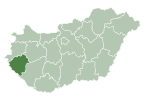| This article needs additional citations for verification. Please help improve this article by adding citations to reliable sources. Unsourced material may be challenged and removed. Find sources: "Hévíz" – news · newspapers · books · scholar · JSTOR (April 2016) (Learn how and when to remove this message) |
| Hévíz | |
|---|---|
 Lake Hévíz Lake Hévíz | |
 Flag Flag Coat of arms Coat of arms | |
 Location of Zala county in Hungary Location of Zala county in Hungary | |
 | |
| Coordinates: 46°47′32″N 17°11′06″E / 46.79234°N 17.18497°E / 46.79234; 17.18497 | |
| Country | |
| County | Zala |
| Area | |
| • Total | 8.31 km (3.21 sq mi) |
| Population | |
| • Total | 4,634 |
| • Density | 560/km (1,400/sq mi) |
| Time zone | UTC+1 (CET) |
| • Summer (DST) | UTC+2 (CEST) |
| Postal code | 8380 |
| Area code | 83 |
Hévíz (Hungarian pronunciation: [ˈheːviːz]) is a spa town in Zala County, Hungary, about 8 kilometres (5 miles) from the city of Keszthely.
Description of the lake
The town is located near Lake Hévíz, the world's second-largest thermal lake, but biologically the biggest active natural lake. Its temperature is affected by the combination of hot and cold spring waters, coming from 38 meters underground. The water breaks out from a spring cave, at approximately 410 liters per second, with a temperature of 40 °C (104 °F). The biological stability of the lake is shown by the temperature of the water, which has not changed for years and even on the coldest winter days does not drop below 24 °C (75 °F). That makes bathing possible in the lake year round. In the summer, the water temperature can reach 37 °C (99 °F).
History
The lake's healing properties have been well known for centuries by people who lived here, as far back as the end of the Stone Age. The foundation of bath culture was laid by the Romans in the 2nd century. The city and the bath began developing significantly in the 18th century, related to the Festetics family, who started scientific research about using the water for healing.
Attractions to the city
The city provides facilities for visitors seeking to use the medicinal waters of the lake, including entertainment, hotels, parks, and sports.
- Dr. Schulhof Vilmos Promenade
- Pedestrian Zone
- Building of the City-hall
- Church from the Arpadian age
- Heart of Jesus church
- Holy Spirit Catholic Church
- Calvinist church
- Art Cinema
- Local collections - museum
- Cafeterias
- Egregy Wine Cellars
- Museum of Egregy
- Tomb of the Roman soldier
- Roman ruin garden
- Farmers' market of Hévíz
- Calvary in Egregy
- Water lily nature trail and treetop walkway
See also
- Hévíz Spa
- Lake Hévíz
- Sármellék International Airport, aka Hévíz-Balaton Airport
Gallery
References
- Gazetteer of Hungary, 1 January 2015. Hungarian Central Statistical Office.
- "Spa Hévíz". Archived from the original on 12 May 2016. Retrieved 26 April 2016.
- "Spa Hévíz". Archived from the original on 12 May 2016. Retrieved 26 April 2016.
- "Spa Hévíz". Archived from the original on 12 May 2016. Retrieved 26 April 2016.
- "Evolution of the bathing culture in Hévíz".
- "Sights in Hévíz".
External links
- Official site (in English)
- Hévíz Virtual Tour, Hévíz Video Portal (in English)
- Hévíz (in Hungarian)
- Hévíz at funiq.hu (in English)
| Hungary's most flowery settlements | |
|---|---|
| Towns and cities |
|
| Villages |
|











